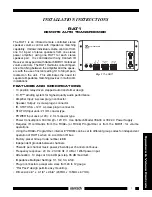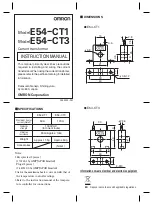
IR T01 Small Area Loop Infrared Transmitter
Recycling Instructions
Please help Williams Sound protect the environment. Please take the time to
dispose of your equipment properly.
Product Recycling for Customers in the European Union:
Please do NOT dispose of your Williams Sound equipment in the
household trash. Take the equipment to a electronics recycling center, or
return the product to the factory for proper disposal.
System Overview
The IR T1 is a two-channel infrared transmitter combining infrared modulator and
emitter technology into a single mountable enclosure—which reduces operating
costs, eliminates the need for rack space and eases set-up.
The IR T1 is ideal for high quality audio programs such as music, television
audio, and audio description. The IR T1 will accept any line level stereo audio
input. Infrared receivers detect the transmission and convert the light signals
back into audio signals. The IR T1 operating frequencies (2.3/2.8 MHz) minimize
high efficiency lighting interference.
No FCC license or radio approval is required with this equipment. It can be used
anywhere in the world.
NOTE: This equipment has been tested and found to comply with the limits for
a Class B digital device, pursuant to part 15 of the FCC Rules. These limits are
designed to provide reasonable protection against harmful interference when the
equipment is operated in a commercial environment. This equipment generates,
uses, and can radiate radio frequency energy and, if not installed and used in
accordance with the instruction manual, may cause harmful interference to radio
communications. Operation of this equipment in a residential area may cause
interference, in which case the user will be required to correct the interference at
his own expense.
NOTE: A PLASMA MONITOR OR TELEVISION CAN DEGRADE THE AUDIO
QUALITY OF THE IR T1 TRANSMITTER. FOR BEST PERFORMANCE, THE
TRANSMITTER SHOULD BE POSITIONED AS FAR AWAY AS POSSIBLE FROM
ANY PLASMA MONITOR, TELEVISION OR OTHER INTERFERING DEVICES.
Installation Procedures
Determine Coverage Area
When using the IR T1 transmitter with the RX22-4 receiver, the system coverage
area will exceed 1000 sq. ft. (93 sq. m.). Figure 1 illustrates typical coverage
pattern for the IR T1. This can be affected by direct/indirect sunlight, reflections on
walls, objects in the room and room construction. The patterns illustrated are the
direct radiation pattern. Most objects block infrared light, so the transmitter cannot
be concealed behind walls, glass, curtains, etc. The infrared radiation does not
drop to zero outside the illustrated patterns; it decreases. It still may be useable
at a greater distance, depending on the receiver sensitivity and the reflective
characteristics of the room.
Important: Remember to point the transmitter towards the listening audience. The front
is the surface with the Williams Sound logo as shown on the cover of this manual.
See Figure 1.


























